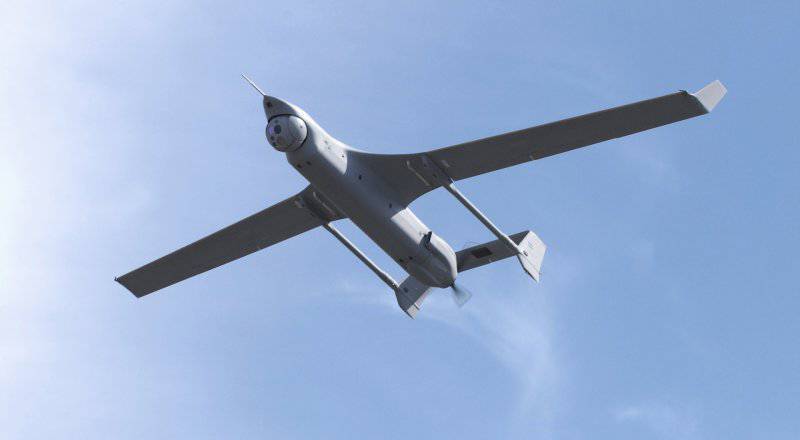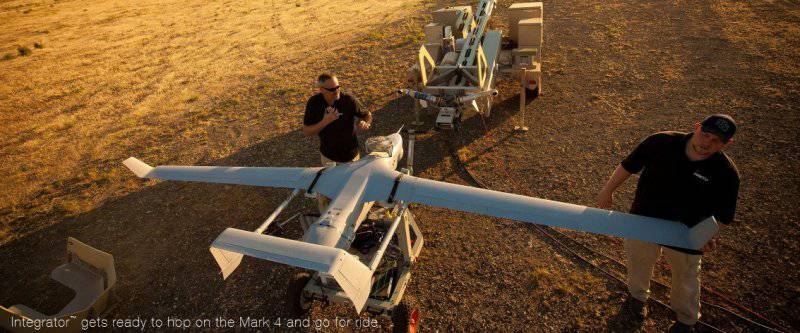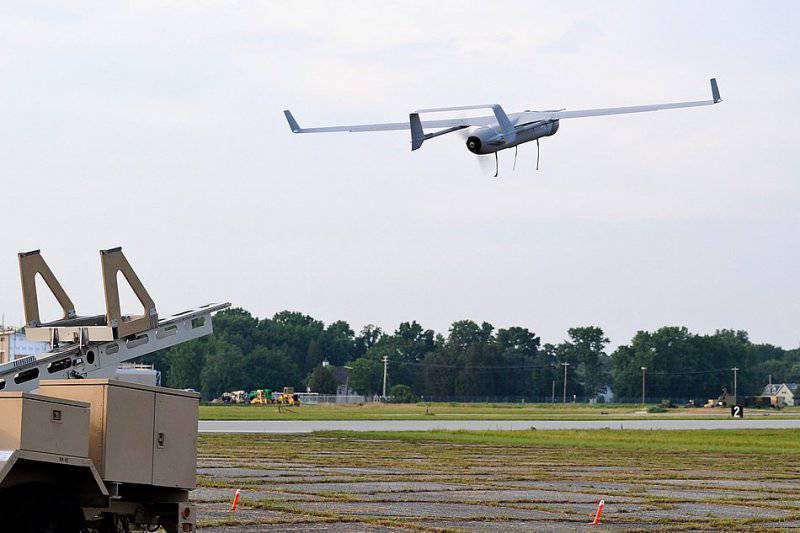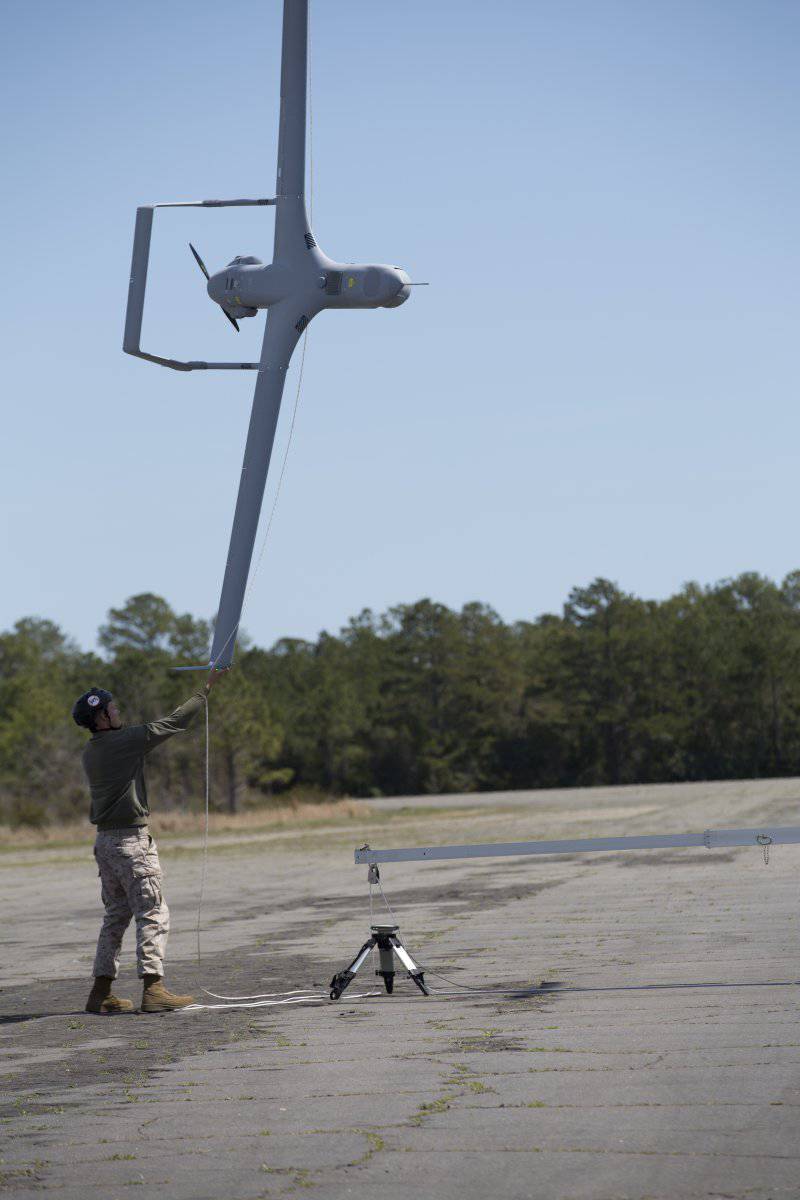Unmanned aerial vehicle Boeing Insitu RQ-21A Blackjack
Since the end of the last decade, the American company Boeing Insitu has been working on the RQ-21 Blackjack unmanned aerial vehicle project. This device was developed by order of the Marine Corps and the US Navy. The main purpose of the machine is reconnaissance, patrolling in specified areas and the detection of various objects. To date, all design work has been completed and full-scale construction of new drones.
UAV RQ-21 was developed as part of the STUAS program (Small Tactical Unmanned Aircraft System - “Small tactical unmanned aviation system"). The purpose of this program was to create a light UAV for operation in the ILC and the Navy. A similar purpose affected the requirements for a promising car. So, it was necessary to make a relatively light machine, capable of patrolling for a long time. In addition, it was supposed to have the smallest possible dimensions for storage on ships. The complex was planned to include a rail launcher for take-off. Landing was required to be carried out using a system that allows you to do without a large platform.
In addition to Boeing Insitu, several other companies participated in the STUAS program. Raytheon introduced the Killer Bee UAV (now known as Northrop Grumman Bat), AAI proposed the Aerodyne project, and General Dynamics (USA) and Elbit Systems (Israel) entered the program with the Storm project. The development of preliminary projects and their comparison continued until the middle of 2010. In June, the customer made his choice of 2010. The best of the proposed projects in the Pentagon considered Boeing Insitu RQ-21A Integrator (the name of the project was in its early stages). To complete the project, the developer was allocated 43,7 million dollars.
The basis for the project RQ-21A was the previous development of the company Boeing Insitu - UAV ScanEagle. The new drone "inherited" a number of units and technical solutions. However, the specifics of the requirements of the Marine Corps and Navy made it necessary to significantly revise the original project. So, all this led to a radical change in the appearance and layout of the device.
UAV RQ-21 from the point of view of aerodynamics is a two-beam high plane with a pushing propeller. The fuselage and fender of the Integrator / Blackjack were made by processing the corresponding units of the ScanEagle UAV. The new machine has an elongated fuselage of a characteristic shape, inside which is installed the engine and various equipment.
In the middle part of the fuselage there is a high wing with a span of 4,8 m. The wing with a large elongation has a slight sweep along the leading edge. At the junction of the wing and fuselage, the center section has a characteristic rounded flow. At the ending there are so-called. winglets. The used wing design is designed to ensure the highest possible aerodynamic quality, directly affecting the flight data of the device, primarily the range and duration of the flight.
At the joints of the center section and the wing consoles, two thin beams are fastened to the plane, on which the U-shaped tail assembly is fixed. The latter consists of two keels with rudders and a high stabilizer with a rudder. Taking into account tail beams and tail assembly, the total length of the UAV RQ-21 is equal to 2,5 m.
In the rear fuselage there is a hp 8 piston engine, which uses aviation kerosene of JP-5 and JP-8 grades as fuel. The propulsive propeller located between the two tail beams is used as a propulsor. The engine used allows the drone to reach a maximum speed of 167 km / h. Cruising speed - 101 km / h. The ceiling reaches 6 km. The fuel available is sufficient to patrol for 16 hours.
UAV RQ-21 Integrator / Blackjack turned out quite easy. Empty weight - 36 kg. Maximum take-off weight with a payload of 17 kg - 61 kg. The small weight of the car allowed to do a relatively low-power engine.
In the forward part of the fuselage of the apparatus, a gyrostabilized installation for surveillance equipment is provided. In the standard configuration, there is an optoelectronic system with a video camera and a thermal imager, as well as a laser range finder and an identification transponder. If necessary, the device may carry additional equipment. To power electronic equipment, the drone is equipped with a 350 watt generator.
To facilitate the design of the aircraft in the project RQ-21 had to use special devices for launching and landing, borrowed from the project ScanEagle. Launch is proposed to implement using rail launchers. The unit is mounted on a towed wheeled chassis. It has a set of equipment and rail guide. On the latter there is a movable carriage with attachments for the drone. Before launching, it is necessary to raise the guide to the desired elevation angle and install the aircraft on the carriage. At the command of the operator, a carriage driven by a pneumatic drive accelerates the UAV to take-off speed, after which it is separated from it and rises into the air.
As a landing gear, it was proposed to use the Skyhook system (“Sky hook”). It is a towed platform with a lifting boom on which there is a cable. To land a drone, it is necessary to raise the boom and bring the cable to a vertical position. Next, the UAV, using a radio beacon, goes to the landing course. The operator or automatics must direct the device on the landing gear in such a way as to grab the cable with a special hook mounted on the wing. After that, the cable is stretched and dampens the horizontal speed of the UAV, after which it can be lowered to the ground or to the deck of the ship.
The composition of the unmanned aircraft complex Boeing Insitu RQ-21A Integrator / Blackjack includes five aircraft, two control panels on a wheeled chassis, as well as towed trailers with a launcher and the Skyhook system. Such a composition of the complex allows it to be used both in ground forces and in the ILC or Navy with basing equipment on ships.
28 July 2012, the company Boeing Insitu specialists conducted the first test launch of a new drone. The device successfully separated from the launcher, executed the flight program and "sat down" using the Skyhook system. Later several more test flights were conducted. For example, in early September 2012, the flight duration exceeded one hour for the first time.
In early February 2013, the RQ-21A complex was delivered aboard the USS Mesa Verde (LPT-19) landing craft. February 10 was the first launch from the deck. For several months, experts checked the operation of the unmanned complex when used in the interests of fleet or ILC.
February 19 American experts began flight tests of a new modification of the drone - RQ-21A Block II. It differs from the basic version with some design features, as well as with the equipment used. To monitor the situation, this UAV received an updated NightEagle optical-electronic system, which was developed as part of the ScanEagle project. The upgraded optoelectronic system has higher performance when working at night and in hot climates. Further testing of UAVs RQ-21A and RQ-21A Block II were conducted in parallel.
In September 2013, the project Integrator received a new name - Blackjack. Soon, at the end of November, the developer company received a contract worth 8,8 million dollars, the purpose of which was to prepare for the mass production of new UAVs. The first production complex, the RQ-21A, was transferred to the Marine Corps in January 2014.
The main customer of new unmanned aerial vehicles should be the USMC. Currently, Boeing Insitu fulfills the order of the Corps for the supply of 32 complexes. The composition of each of them includes five drones. Before 2017, the Marine Corps intends to purchase 100 Blackjack system kits. It is expected that the cost of the entire order will remain at the level of 560 million dollars.
The US Navy also expressed their desire to acquire new UAVs. There is an order for 25 complexes with five aircraft in each.
Earlier it was reported that in the 2014 year, the Royal Netherlands could receive their first RQ-21A Blackjack. This structure expressed the willingness to acquire five unmanned systems. Another six complexes could be acquired by an unnamed Middle Eastern country. There is no information about this contract.
In April, the 2014 of the year, the USMC began operating the RQ-21A UAV in Afghanistan. A complex of five UAVs, two control units and a set of other equipment was delivered to one of the bases. Blackjack vehicles were used to conduct reconnaissance and detection of enemy targets. In September, it was reported that for 119 days of operation in Afghanistan, the total raid of UAVs was 1000 hours. The RQ-21A complex has proven itself, as a result of which its operation in Afghanistan continued.
On the materials of the sites:
http://insitu.com/
http://naval-technology.com/
http://navaldrones.com/
http://arms-expo.ru/
http://globalsecurity.org/




Information